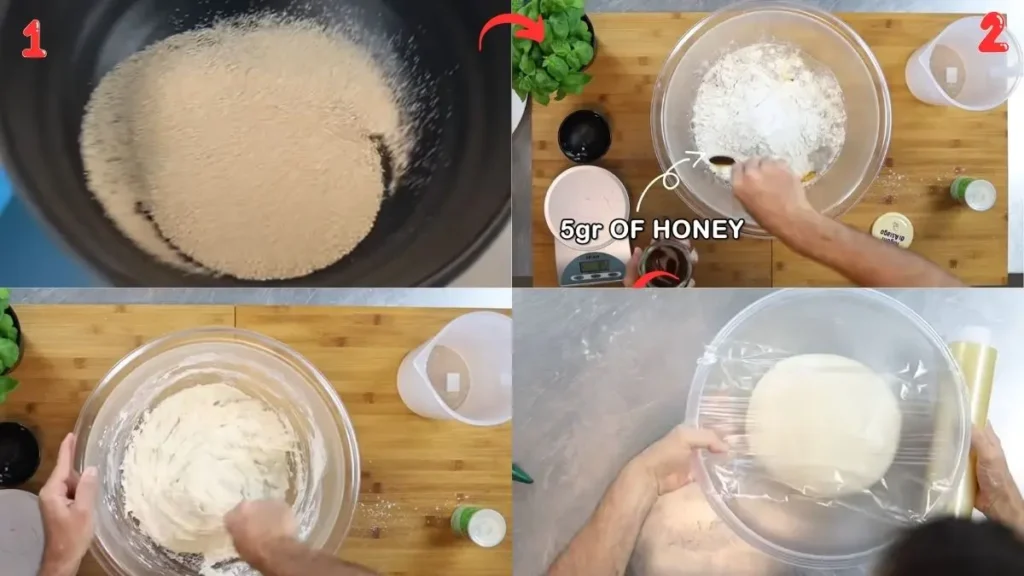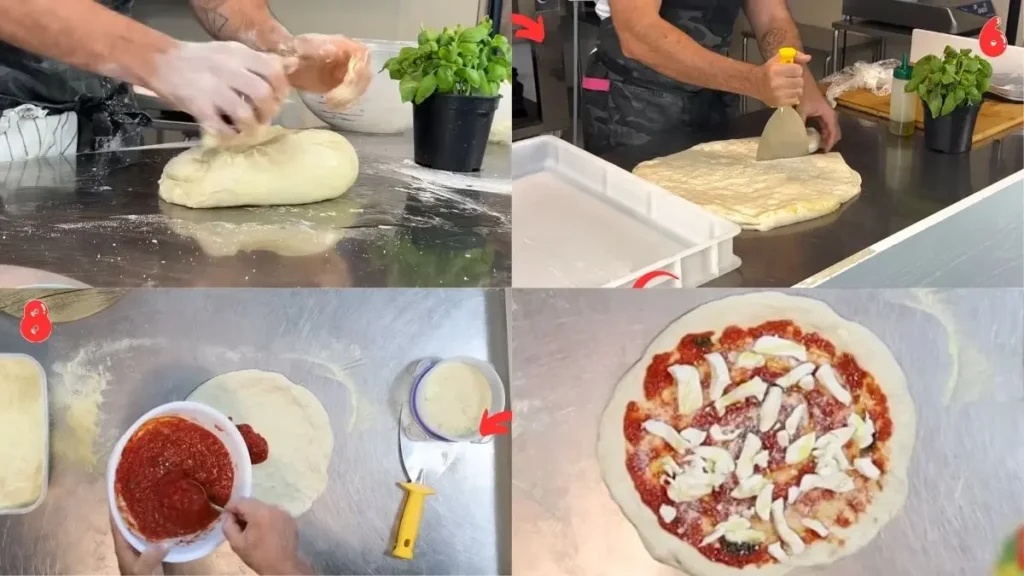Hey guys! So, like… have you ever wanted to make pizza at home that tastes, like, really good? Well, guess what? This Vito Iacopelli Poolish Pizza Dough Recipe is just wow. It’s soft and crunchy and just-perfect.
This recipe comes from Vito Iacopelli. He’s, like, a pizza master! And the best part? You can make it in your electric oven at home. Yup, no wood oven needed.
It’s called poolish pizza dough. Kinda funny name, right? But trust me, it makes the pizza light and full of air bubbles. So fluffy! Let’s make it together, step by step. You’re gonna love it.
Why You Will Love This Vito Iacopelli Poolish Pizza Dough
Oh wow-where do I even start? First, it’s like magic. Seriously! This dough is soft and crunchy at the same time. It’s just so good. You’ll feel like a real pizza chef at home.

Also, it’s super fun to make. You mix it with your hands, like it’s your baby! And don’t worry-it’s not hard. You just need time. It rests, it bubbles, and then-boom-it’s pizza time.
And the best part? You can bake it in your home oven. No big fancy oven needed. So yeah, if you love pizza (and who doesn’t?), this dough will totally make you smile. Yum!
Ingredients Used in This Vito Iacopelli Poolish Pizza Dough Recipe
For the Poolish (100% hydration pre-ferment):
- 1 liter cold water
- 5g dry yeast
- 5g honey (or organic sugar if preferred)
- 1kg flour (preferably Type 00)
For the Final Dough:
- All of the prepared poolish
- 450g flour (Type 00)
- 30g salt
- 5g dry yeast
- 30g extra virgin olive oil
Essential Kitchen Equipment Required
- Large mixing bowl
- Spatula and scale
- Plastic wrap or container with lid
- Dough scraper
- Clean kitchen surface or countertop
- Electric oven and Pizza stone
- Scissors (for slicing, optional but fun!)
Preparation Time: 30 minutes
Poolish Fermentation: 1 hour at room temperature + 24 hours in the fridge
Dough Resting Time: 20 minutes + 24 hours in the fridge
Final Proofing Time: 1–2 hours at room temperature
Cooking Time: 6–8 minutes (electric oven at 250°C)
How To Make Vito Iacopelli Poolish Pizza Dough
1. Make the Poolish (Pre-ferment)
In a large bowl, combine 1 liter of cold water with 5g of dry yeast. Mix using two fingers or a spoon. Add 5g of honey (or substitute with organic sugar). Mix in 1kg of flour until the texture becomes a smooth, pourable batter. Cover the bowl with plastic wrap, poke a few holes, and let it rest at room temperature for 1 hour. Transfer to the refrigerator and ferment for 24 hours.

2. Prepare the Final Dough
Remove the poolish from the fridge. Let it rest briefly at room temp. Add 5g of dry yeast and 450g of flour. Mix lightly. Add 30g of salt and incorporate gently. Transfer to a floured counter and knead for 5–10 minutes, folding and pressing until smooth. Pour 30g olive oil onto the surface and knead again until the dough is elastic and glossy. Let the dough rest 20 minutes, covered.
3. Bulk Fermentation & Dough Balling
Place the dough in a clean, oiled container, cover tightly, and refrigerate for another 24 hours. Remove and let it come to room temperature for 1–2 hours. Portion the dough into 280g balls using a digital scale. Shape each ball by folding the dough inwards, creating surface tension on top. Place dough balls in a proofing tray with a few fingers of space between each. Cover and let rest for another 1–2 hours.
4. Stretching & Topping
Preheat your electric oven to 250°C with a pizza stone or steel inside. Lightly flour your counter. Remove a dough ball and press gently from center outward to stretch, preserving air in the crust. Top with: Crushed tomato sauce, Fresh mozzarella, Grated Parmesan, Basil leaves, Drizzle of olive oil.

5. Bake to Perfection
Transfer to the hot stone/steel and bake for 6–8 minutes, or until the crust is golden and mozzarella is bubbling. Optional: brush the crust with a touch of olive oil post-bake for extra flavor and sheen.
Notable Tips to Make This Vito Iacopelli Poolish Pizza Dough Recipe Perfect
Here are some notable tips, that can help you to make this recipe perfect in the very first attempt. Check below
Cold water is key!
Use cold water when making the poolish. Warm water will wake up the yeast too fast. We want it to sleep slow and make yummy bubbles!
Don’t forget the honey!
Honey helps the yeast eat and grow. If you don’t have honey, a little sugar is okay-but honey is better!
Stir like you care.
Mix the poolish gently. Pretend it’s a baby! Be kind to your dough, and it will be kind back.
Let it nap!
After you mix the poolish, let it rest in the fridge for 24 hours. It’s tired and needs sleep to grow strong.
Knead with love.
When mixing the final dough, press and fold. Press and fold. It’s like giving the dough a little workout!
Olive oil is magic.
Add the olive oil last and mix it in well. It makes the dough smooth and shiny, like pizza lotion!
Use a scale!
Weigh your dough balls to make sure they’re all the same size. That way, they cook nice and even.
No flour on top!
When making dough balls, use oil on your hands-not flour! Too much flour changes the dough.
Give the dough space.
Leave room between dough balls in the tray. They need space to grow-like little balloon friends!
Cook it hot and fast!
Use your oven at 250°C. That’s hot! The pizza cooks quick and gets a yummy crust-crispy and soft at the same time!
Some Delicious Ways to Enjoy This Vito Iacopelli Poolish Pizza Dough
Whether it’s a party, family function or you are enjoying this Vito Iacopelli Poolish Pizza Dough at your home, the following serving ideas can make your meal more comfortable and delicious to enjoy.
1. Classic Margherita with a Glass of Chianti
Let’s be honest-nothing beats the simple beauty of a Margherita. That buttery mozzarella, sweet tomato sauce, and basil atop this light, airy dough just works. Pair it with a glass of Chianti and you’ve got a dinner that feels straight out of Naples.
2. White Pizza with Ricotta, Garlic, and Spinach
One night we skipped the tomato sauce and spread on some whipped ricotta with roasted garlic and wilted spinach. The dough baked beautifully under the cheese, giving us that soft bottom with crisp edges. It’s rich but light – dangerously addictive.
3. Caramelized Onion & Gorgonzola with Arugula
This combo is for blue cheese lovers. We top the dough with slow-cooked onions, dollops of gorgonzola, and finish it post-bake with peppery arugula. The sweetness, saltiness, and slight bitterness all play perfectly with the fermented dough’s complexity.
4. Prosciutto, Fig Jam & Burrata
We served this once at a small dinner party – blew everyone’s minds. After baking the pizza base plain, we topped it with fig jam, torn burrata, and slices of prosciutto. Finished with a crack of black pepper. Elegant and indulgent.
5. Spicy ‘Nduja with Fresh Mozzarella & Basil
If you’re in the mood for a little heat, a light layer of tomato sauce with spicy ‘nduja sausage and pools of mozzarella hits the spot. The fat from the ‘nduja melts into the crust and caramelizes beautifully. Don’t skip the basil – it cools it down just enough.
6. Breakfast Pizza with Egg, Bacon & Scallions
Yes, we’ve eaten this dough for breakfast (and no regrets). After a par-bake, we cracked an egg in the center, added crumbled crispy bacon, and sprinkled scallions. It comes out gooey and golden. Add hot sauce and coffee for the full brunch effect.
7. Mushroom Truffle Pizza with Fontina
We had some leftover mushrooms and decided to go earthy: sautéed creminis, shredded fontina, and a drizzle of white truffle oil post-bake. This dough holds moisture so well that even a juicy mushroom mix doesn’t sog it out.
8. Four-Cheese with a Drizzle of Hot Honey
Cheddar, mozzarella, gorgonzola, and fontina melted on top of this pizza dough create a melty, tangy masterpiece. We finish with hot honey for that sweet heat. It’s like adult comfort food.
9. Serve as a Side with Caesar Salad
Sometimes, we bake the dough plain (a little olive oil and flaky salt) and slice it into strips to dip into Caesar dressing. It’s chewy, golden, and acts like the world’s best pizza breadstick. Add anchovies if you’re brave.
10. Dessert Pizza with Mascarpone and Fresh Berries
One night we baked a thin crust, let it cool slightly, and topped it with mascarpone, a drizzle of honey, and fresh raspberries and strawberries. A dusting of powdered sugar sealed the deal. Think pizza, but romantic.
How to Store and Reheat This Vito Iacopelli Poolish Pizza Dough Properly
To store Vito Iacopelli Poolish Pizza Dough, wrap it tightly in plastic wrap or place it in an airtight container and refrigerate for up to 3 days. For longer storage, freeze the dough after shaping into balls. To reheat, allow the dough to come to room temperature before stretching and baking at 250°C in a preheated oven.

Vito Iacopelli Poolish Pizza Dough Recipe
Hey guys! So, like… have you ever wanted to make pizza at home that tastes, like, really good? Well, guess what? This Vito Iacopelli Poolish Pizza Dough Recipe is just wow. It’s soft and crunchy and just-perfect.
Ingredients
- 1 liter cold water
- 5g dry yeast
- 5g honey (or organic sugar if preferred)
- 1kg flour (preferably Type 00)
- All of the prepared poolish
- 450g flour (Type 00)
- 30g salt
- 5g dry yeast
- 30g extra virgin olive oil
Instructions
1. Make the Poolish (Pre-ferment)
In a large bowl, combine 1 liter of cold water with 5g of dry yeast. Mix using two fingers or a spoon. Add 5g of honey (or substitute with organic sugar). Mix in 1kg of flour until the texture becomes a smooth, pourable batter. Cover the bowl with plastic wrap, poke a few holes, and let it rest at room temperature for 1 hour. Transfer to the refrigerator and ferment for 24 hours.
2. Prepare the Final Dough
Remove the poolish from the fridge. Let it rest briefly at room temp. Add 5g of dry yeast and 450g of flour. Mix lightly. Add 30g of salt and incorporate gently. Transfer to a floured counter and knead for 5–10 minutes, folding and pressing until smooth. Pour 30g olive oil onto the surface and knead again until the dough is elastic and glossy. Let the dough rest 20 minutes, covered.
3. Bulk Fermentation & Dough Balling
Place the dough in a clean, oiled container, cover tightly, and refrigerate for another 24 hours. Remove and let it come to room temperature for 1–2 hours. Portion the dough into 280g balls using a digital scale. Shape each ball by folding the dough inwards, creating surface tension on top. Place dough balls in a proofing tray with a few fingers of space between each. Cover and let rest for another 1–2 hours.
4. Stretching & Topping
Preheat your electric oven to 250°C with a pizza stone or steel inside. Lightly flour your counter. Remove a dough ball and press gently from center outward to stretch, preserving air in the crust. Top with: Crushed tomato sauce, Fresh mozzarella, Grated Parmesan, Basil leaves, Drizzle of olive oil
5. Bake to Perfection
Transfer to the hot stone/steel and bake for 6–8 minutes, or until the crust is golden and mozzarella is bubbling. Optional: brush the crust with a touch of olive oil post-bake for extra flavor and sheen.
Notes
To store Vito Iacopelli Poolish Pizza Dough, wrap it tightly in plastic wrap or place it in an airtight container and refrigerate for up to 3 days. For longer storage, freeze the dough after shaping into balls. To reheat, allow the dough to come to room temperature before stretching and baking at 250°C in a preheated oven.
Nutrition Information:
Yield: 4 Serving Size: 1Amount Per Serving: Calories: 231
FAQs on This Vito Iacopelli Poolish Pizza Dough Recipe
Here, we’ve got you covered with some common questions about the Vito Iacopelli Poolish Pizza Dough Recipe that people often ask.
1. What is the ratio of poolish to pizza dough in this recipe?
This recipe uses 100% poolish, which means the pre-ferment (poolish) makes up the entire water and a large portion of the flour in the final dough. Specifically, the poolish includes 1 liter of water and 1kg of flour, and then we add just 450g more flour later. From our experience, this gives the dough its signature airy structure and deep flavor.
2. What type of pizza flour does Vito Iacopelli use?
Vito swears by Type 00 flour, ideally something finely milled with a high protein content (around 12–13%). From our experience, brands like Caputo or Petra are great picks if you’re aiming for that same soft, elastic dough that stretches beautifully and crisps up just right in an electric oven.
3. Is pizza dough better with poolish?
Absolutely-especially if you’re baking in a home oven. Poolish brings out more fermentation flavor, improves digestibility, and gives you that open crumb and soft-yet-crispy texture. After testing both methods multiple times, we can confidently say: if you have the time, go poolish.
4. Can I use sugar instead of honey in the poolish?
Yes, but choose something organic and unrefined like raw cane sugar or brown sugar. We’ve tried both, and while they work, honey gives the poolish a subtle floral note and slightly better fermentation activity. If you can, stick with honey-just 5 grams makes a difference.
5. How long should I ferment the poolish?
We follow Vito’s method exactly: 1 hour at room temperature, then 24 hours in the fridge. Trust us, don’t skip the cold ferment-it gives the dough depth of flavor and an incredible lightness.
6. Do I need to bring the dough to room temperature before baking?
Yes, and it’s important! After balling the dough, let it rest 1–2 hours at room temperature before stretching. This allows the gluten to relax and the dough to reach the perfect fermentation point. From our experience, this is when the dough is easiest to work with and the crust comes out just right.
7. Can I use this recipe in a wood-fired oven?
Technically yes-but it’s optimized for electric ovens. The hydration level and oil content are dialed in for longer, lower-heat bakes. We’ve tested it in both, and while it works in a wood-fired oven, you might need to adjust the baking time and hydration for best results.
8. My dough is very sticky after mixing-is that normal?
Totally normal with 100% poolish. It’s a high hydration dough, so it’ll feel a bit sticky at first. Use a dough scraper, give it time to rest, and don’t panic. Once the olive oil is added and the gluten strengthens, it becomes much easier to handle.
9. How many pizzas does this recipe make?
This recipe makes about 6 dough balls at 280g each, which is perfect for 10–12 inch Neapolitan-style pizzas. If you’re making smaller pizzas or want thinner crusts, you can stretch it to 7–8 pizzas easily.
10. How do I know when the dough is ready to be baked?
Look for the “perfect fermentation point,” as Vito calls it. The dough balls should be soft, puffy, and doubled in size, but not collapsed or sticky. From our experience, you’ll start to recognize this “sweet spot” after a few tries. When in doubt, give it the poke test-if it springs back slowly, it’s ready.
As Vito says, “There’s no secret in this channel-only passion.” If you found this recipe helpful, share it with a friend and don’t forget to subscribe to the pizza lifestyle.
Drop a comment on the blog with your feedback-I can’t wait to hear what you think.
Also, follow along on Pinterest and Reddit for more tasty updates. Your support and thoughts mean the world!


1 comment